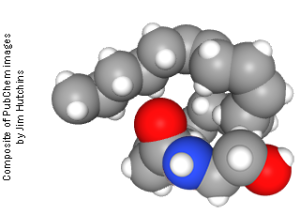The Arachadonic Acid Second Messenger System
Lyndsay Woelfel and Jim Hutchins
Chapter under construction. This is the first draft. If you have questions, or want to help in the writing or editing process, please contact hutchins.jim@gmail.com.

What is arachidonic acid (AA)?
Arachidonic acid is characterized as a 20-carbon polyunsaturated fatty acid with four double bonds. Its metabolites are prostaglandins and leukotrienes, which are considered intracellular. It is normally found in human and animal fat. It is also found in the liver, brain, and glandular organs.
This is synthesized from dietary linoleic acid. Either by being demanded by G protein-regulated phospholipase A2 or diglyceride lipase activation, bioactive metabolites are produced.
The three major groups of metabolites are:
Prostaglandins: Lipid compounds that are hormone like substances. These play a role in inflammation, pain, blood flow, fever, kidney function, and reproduction.
Thromboxane: Eicosanoids and a group of lipid compounds. These play a role in vasoconstriction and platelet aggregation.
Leukotrienes: Eicosanoid inflammatory mediator. These play a role in allergic reactions, bronchoconstriction, and inflammation in airways.

Anandamide
Anandamide is an N-acylethanolamine 20:4. This comes from formal condensation of a carboxy group of arachidonic acid. This one has the amino group of ethanolamine. Anandamide is a neurotransmitter, as well as a vasodilator and human blood serum metabolite. Functionally, it is related to an arachidonic acid and is an endocannabinoid.
This produces the highest effects of tetrahydrocannabinol (THC). It’s a cannabinoid receptor agonist and stimulates activity of cannabinoid receptors.
The function of this neurotransmitter is to interpret pain perception, mood, memory and appetite. This substance is naturally produced in our bodies and can improve mood when it attaches to some neurotransmitters
Arachidonic Acid Cascade:
The arachidonic acid cascade is what our body uses to produce inflammation in the body in order to control an injury, inflammation or pain.
Cyclooxygenase (COX): COX-1 and COX-2 convert arachidonic acid to unstable cyclic endoperoxides. These are metabolized into prostaglandins, prostacyclin and thromboxane
Lipoxygenase (LO): Arachidonic acid is converted into leukotrienes and lipoxins.
Cytochrome P450 (CYP450): Metabolize arachidonic acid into epoxyeicosatreinoic acids (EETs), dihydrozyeicosatetraenoic acids (diHETEs), and eicosatetraenoic acids (ETEs).
 Anandamide interacts with both the Cannabinoid 1 receptor (nervous system) and the Cannabinoid 2 receptor (peripheral nervous system). It is a main endogenous agonist of cannabinoid receptors and is able to replicate the effects of THC.
Anandamide interacts with both the Cannabinoid 1 receptor (nervous system) and the Cannabinoid 2 receptor (peripheral nervous system). It is a main endogenous agonist of cannabinoid receptors and is able to replicate the effects of THC.

Tetrahydrocannibinol (THC)
Anandamide causes a feeling of happiness, as does THC. THC is a psychoactive compound and is the primary ingredient in marijuana, it produces a range of both positive and negative therapeutic effects.
The endocannabinoid system (ECS) is receptors, enzymes, and signaling molecules coming together in a complex network to play a crucial role of regulating both physiological and psychological processes. Endocannabinoids themselves are chemicals in the body that are naturally produced. They bind with cannabinoid receptors that are proteins on the surface of cells. CB1 is normally found in the brain and nervous system, while CB2 is primarily found in the immune system. The ECS plays a massive role in the brain’s reward system, and may influence behaviors like drug addiction. THC interacts with the ECS and binds to both cannabinoid receptors, it produces very similar effects to anandamide.
References (still need to properly format)
https://www.nature.com/articles/4401284
https://www.acnp.org/g4/GN401000059/CH059.html#:~:text=In%20both%20cases%2C%20the%20arachidonic%20acid%20cascade,receptor%2Ddependent%20formation%20and%20intracellular%20site%20of%20action.&text=In%20addition%20to%20these%20actions%20mediated%20by,or%20intervention%20of%20other%20second%20messenger%20pathways.
Media Attributions
- Arachidonic-Acid Conformer © PubChem adapted by Jim Hutchins is licensed under a Public Domain license
- Anandamide space filling © PubChem adapted by Jim Hutchins is licensed under a Public Domain license
- Eicosanoid pathways © BioRender adapted by Jim Hutchins is licensed under a CC BY-NC-ND (Attribution NonCommercial NoDerivatives) license
- Dronabinol Conformer © PubChem adapted by Jim Hutchins is licensed under a Public Domain license

